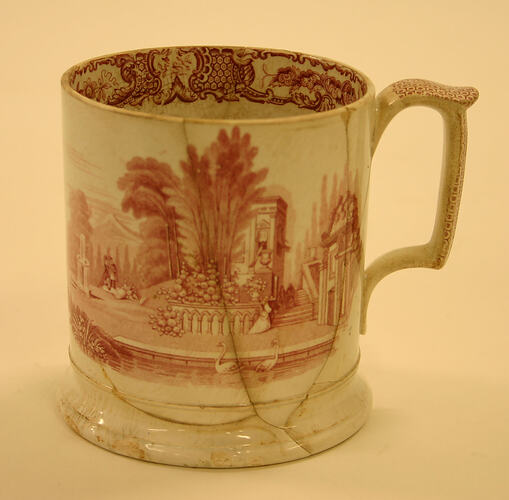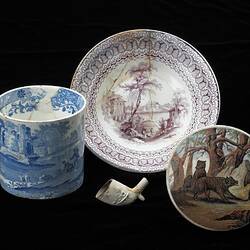Summary
This ceramic mug or tankard was reconstructed from a group of seven fragments that were excavated at one of the digs on the Commonwealth Block between 1988 and 2003. It was manufactured by Copeland and Garrett between 1833 and 1847 at the Spode Works in Stoke-on-Trent, Staffordshire, England.
Homewares.
Numerous crockery pieces were found all over the Little Lon site. Crockery gives us a glimpse of everyday life in Melbourne in the 1880s. In the houses around Little Lon, residents used decorated crockery. Most pieces were cheap earthenware or stoneware, yet provided colour and cheer. Only a few could afford to buy matching sets, and most china was probably acquired second-hand. Some were once expensive pieces. Householders mixed and matched their crockery from the great range of mass-produced designs available. 'Blue and white' and the 'willow' pattern, was the most popular choice and was produced by English potteries from 1790.
Physical Description
This reconstructed mug has a red and white transfer printed pattern of a rural or castle scene. The handle has a honeycomb pattern and the inside rim is decorated with a floral design. There is a manufacturer's mark on the base. The cup design is Alp.
Physical Description
7 fragments of ceramic tankard or mug with red and white transfer print. Rural/castle scene. Handle has honeycomb pattern. Pattern on inside rim, floral. Base diameter 110mm, height 115mm. Manufacturers mark on base. Alp design. Crown with Copeland and Garrett, Spode Works, Stoke, made between 1833 and 1847. Pattern name is 'Watteau'. Made by Copeland and Garrett, Spode Works, Stoke, c. 1833-47. See photocopied material in Supplementary file
More Information
-
Collection Names
-
Collecting Areas
-
Acquisition Information
Transfer from Heritage Victoria, Industry Superannuation Property Trust, 03 May 2005
-
Manufacture Name
-
Manufacture Date
-
Manufacturer
Copeland and Garrett, Stoke-on-Trent, Staffordshire, England, Great Britain, 1833-1847
-
Inscriptions
On base: 'COPELAND AND GARRETT.4.ALP' an impressed circle is on the 'P', '7' painted in blue within a circle. where an impressed circle is on the 'P' also '7' painted in blue within a circle
-
Context Number
19/49
-
Site
[CCS] Australia, Victoria, Commonwealth Block, Melbourne
-
Activity
-
Specific Activity
-
Decoration
-
Colour
Red
-
Moulding
Classical Scene
-
Form
Straight Rim; Cylindrical Body; Pedestal Foot (Base)
-
Shape
Round
-
Provenance
England, Staffordshire
-
Classification
-
Category
-
Discipline
-
Type of item
-
EAMC Measurements
115 mm (Height), 110 mm (Outside Diameter)
-
References
A.W. Coysh & R.K. Henrywood 'The Dictonary of Blue & White Printed Pottery
93 Pages
-
Keywords


